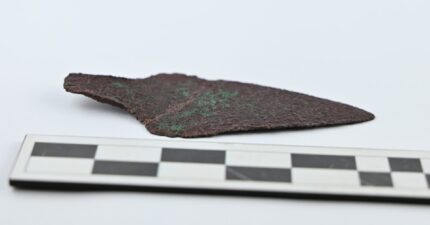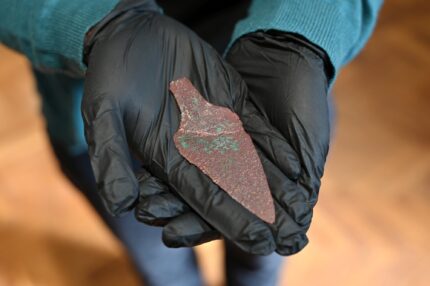 A rare copper dagger dating back more than 4,000 years has been discovered in a forest near Jarosław, southeastern Poland. Shaped like a flint dagger from the period, it is just over four inches long, but that is actually a large dagger compared to similar such finds because the metal was hard to come by and very valuable. This is the oldest dagger ever discovered in the Subcarpathian Voivodeship (province).
A rare copper dagger dating back more than 4,000 years has been discovered in a forest near Jarosław, southeastern Poland. Shaped like a flint dagger from the period, it is just over four inches long, but that is actually a large dagger compared to similar such finds because the metal was hard to come by and very valuable. This is the oldest dagger ever discovered in the Subcarpathian Voivodeship (province).
 The blade was discovered last November by metal detectorist Piotr Gorlach from the Historical and Exploration Association Grupa Jarosław, an organization of local history enthusiasts who search for archaeological materials with the permission of government heritage officials. Gorlach was looking for military objects from the World Wars that day without success. He had given up and was heading towards his car when his detector signaled the presence of metal under the forest floor. He saw the metal piece aged with a green patina and quickly realized it was much older than shrapnel from World War I. He alerted the voivodeship’s conservator of monuments and archaeologists from the Orsetti House Museum in Jarosław were deployed to examine the find.
The blade was discovered last November by metal detectorist Piotr Gorlach from the Historical and Exploration Association Grupa Jarosław, an organization of local history enthusiasts who search for archaeological materials with the permission of government heritage officials. Gorlach was looking for military objects from the World Wars that day without success. He had given up and was heading towards his car when his detector signaled the presence of metal under the forest floor. He saw the metal piece aged with a green patina and quickly realized it was much older than shrapnel from World War I. He alerted the voivodeship’s conservator of monuments and archaeologists from the Orsetti House Museum in Jarosław were deployed to examine the find.
According to archaeologist Dr. Marcin Burghardt from the Jarosław museum, the dagger discovered in Korzenica can be dated to the second half of the third millennium BC.
“In Polish lands, this is a period of enormous changes related to, among others, with a change in the main raw materials for the production of tools. Instead of flint tools commonly used in the Stone Age, more and more metal products appear, heralding the transition to the next period – the Bronze Age,” noted Dr. Burghardt.
He added that in this new era, tools, ornaments and weapons were made of bronze, an alloy created by combining two metals: copper and tin.
However, the currently discovered dagger from Korzenica – as noted by Dr. Elżbieta Sieradzka-Burghardt, an archaeologist from the museum in Jarosław – was not cast in bronze, but made of copper. “So it predates the development of bronze metallurgy,” the archaeologist noted. “In the third millennium BC, items made of copper were extremely rare, so only those with the highest social status could afford them. There is no doubt that the dagger is not a local product,” added Dr. Burghardt-Sieradzka.
It likely originated from the Carpathian Basin or the Ukranian steppe. Archaeologists hope metallurgic analysis will pin down the dagger’s origin. The blade is now part of the permanent collection of the Orsetti House Museum in Jarosław. After conservation and further study, it will go on display in June as part of the museum’s exhibition devoted to the oldest prehistory of the Jarosław area.
The tang for the handle is not in line with the blade. Is that offset original or a later bend? Any way it suggests to me that this object might not be a dagger but a tool — a mason’s trowel comes to mind first. Copper would be a strange metal for a dagger, unlikely to retain a sharp edge. Though it is also an unlikely metal for a builder’s trowel, being too soft. The supposed age is odd too. How could a copper blade be dated whatever its use might have been?
Sigh – I messed up withe the link, and therefore come again. *sorry for that*
@Bernie – Yes and no:
Of course, in comparison to “Bronze” (i.e. an alloy of copper and tin) copper on its own is rather soft, and that is, why here the “Bronze Age” may have had already set in, or maybe not (yet).
From a millennium earlier –i.e. from the “Copper- Stone Age”– for example poor Ötzi mainly had flint tools (dagger, arrow heads) with him, but rather extraordinarily, also a copper(!) axe.
Cf. the post from February, 15th. Those folks in Italy got rather similar daggers, but made of flint. Thus, the copper “dagger” would have been a status symbol.
—-
PS: Confusingly, there are -in the Bronze Age- occasional uses of iron, meteoric and not, which is of course even harder than bronze. Today, there are roughly 2000 different kinds of steel available.